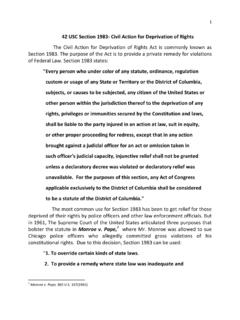Transcription of LTIP Objectives - Hugessen
1 Privately-owned companies enjoy many advantages compared to their publicly-traded counterparts in the current economic and regulatory environment. Their detachment from the public markets allows them to operate under less scrutiny and governance bureaucracy. Yet, it also creates some practical barriers when considering incentive compensation absence of a public market, and the easily-accessible company valuation it supplies, makes it difficult for privately-owned companies to structure, adjudicate and communicate equity compensation to participants. That said, as publicly-traded companies continue to deliver a large portion of total compensation in the form of long-term equity -based awards, some alignment in incentive design can provide private enterprises with a more competitive compensation offering, one that effectively meets the Objectives outlined at Incentive Alternatives at private Companies: An overview | Hugessen Consul0ng 1 LONG-TERM INCENTIVE ALTERNATIVES AT private COMPANIES: A BRIEF OVERVIEWLTIP Objectives The overall Objectives of an long-term incentive plan will influence which design is most appropriate.
2 Common Objectives include:Attract Talent: to attract the right employees, a company will want to consider what is competitive in its industry considering both publicly-traded and private incentive structureIncent Performance: to strike a balance between measures of success for the company / shareholders and over what the employee has line of sight influence. For many organizations, equity compensation plans can effectively support the objective of coalescing the management team around a common goal and share in the company's long-term growthAlignment with Shareholders: to ensure participants have sufficient skin-in-the-game and to reinforce a culture of ownershipRetention of Key Personnel: to ensure sufficient retention mechanisms are in place ( , through deferral of compensation and vesting / forfeiture conditions)As outlined in this briefing, private companies have several options for long-term incentive plans (LTIPs) that can mimic stock compensation and allow participants to share in the longer-term growth in company value enjoyed by shareholders (in cases where real equity ownership is not desired).
3 Selecting appropriate instrument(s) will require careful consideration of several factors not applicable to publicly-traded companies, including company valuation and ongoing campaign by influential shareholders and organizations to have boards and management refocus on longer-term decision-making is sparking conversations around how to apply this mantra to incentive design. As these companies consider moving towards longer-term full share instruments, private companies face similar decisions related to sufficient alignment and the practical application of non-traditional incentives OF LTIP VEHICLESLong-term Incentive Alternatives at private Companies: An overview | Hugessen Consulting 2 Settlement of equity awards with treasury shares (as opposed to cash or market-purchase settlement) can allow for longer awardterms ( , settlement beyond three years) and more flexibility on timing ( , fewer tax limitations) While vesting can still occur after or over three years, at which point the participant has earned the right to the full award, thesettlement of the award can extend longer ( , seven years), thereby deferring the tax impact during that period This structure promotes longer-term alignment with shareholders, however, some complexities can arise when settlement isextended beyond three yearsBONUSDEFERRAL CASH DENOMINATEDUNIT DENOMINATED ( equity -BASED)
4 MULTI-YEARCASH PLAN RESTRICTED SHARE UNITSDEFERRED SHARE UNITSPERFORMANCE SHARE UNITSSTOCK OPTIONS / SARSRESTRICTED SHARE UNITSBONUS DEFERRALMULTI-YEAR CASH PLANPERFORMANCE SHARE UNITSDEFERRED SHARE UNITSSTOCK OPTIONS / SHARE APPRECIATION RIGHTSL onger-term VestingWhat it is: A portion of a participant s annual incentive award is deferred for several years ( , 3 years)What it is: A target award is granted to a participant and is subject to a multi-year performance modifier based on predetermined performance criteriaWhen to use it: Desire to have incentives contingent on forward-looking performance conditions, in the absence of a share priceWhen to use it: Best if used in a focused manner such as a notional ownership vehicle for a top executiveWhen to use it: Desire for stronger pay-for-performance alignment and increased leverage (depending on performance / payout calibration)What it is: Right to participate in the increase in the value of the underlying share unit.
5 Either settled in real shares (stock option) or in cash (stock appreciation right or SAR)When to use it: Desire to provide significant upside leverage to participants (with potential preferred tax treatment)When to use it: Desire to align executives with shareholders and reward for increasing longer-term company value. Retention incentive that is viewed as a "guaranteed" component of compensationWhat is it: Similar to an RSU, but vesting of the award is subject to the achievement of additional forward-looking performance conditionsWhat is it: Similar to an RSU, but paid out only upon exit ( , retirement, termination, etc.)What is it: A notional full share in the company that tracks the value of the underlying stock and vests (is earned) based purely on the passage of time ( , after 3 years)When to use it: Seeking the simplest mechanism to incorporate a retention element into an incentive framework.
6 No desire to incorporate a share price or forward-looking performance conditionsSimilar to publicly-traded companies, private enterprises will need to weigh the pros and cons of settling equity awards in either cash or treasury shares. One major factor is the favourable personal tax treatment for Canadian Controlled private Companies (CCPCs), which offers added tax benefits when using real equity . In either case, companies will have to approach the issues of company valuation and share liquidity carefully. Accounting Treatment Cash: liability accounting Real equity : fixed accounting Company Valuation Long-term Incentive Alternatives at private Companies: An overview | Hugessen Consulting 3 KEY CONSIDERATIONS FOR equity AWARDS Corporate TaxCash: deductible expense for the company Real equity : not deductible by the company Personal TaxCash: taxed as regular incomeReal equity : if a CCPC, initial grant value is taxed at capital gains-like rate.
7 Increase / decrease in value is eligible for capital gains / loss treatment. Also, individuals have a life-time capital gains exemption of $824,000 With no public marketplace to facilitate the purchase and sale of equity , the company is typically responsible for providing liquidity to the plan participants. The liquidity requirements can be managed through careful planning and budgeting, scenario-testing, and the implementation of certain safeguards ( , cap on trading to ensure fundability, prohibition of trading between employees, no commitment under extraordinary circumstances) Settlement MethodCONCLUDING THOUGHTS As evidenced by usage levels among publicly-traded companies, LTIPs are viewed as effective tools to incent executives to focus on goals that extend beyond the short-term and share in long-term growth in company value.
8 Two final thoughts: 1. When considering adopting an LTIP at a private company, it will be important to weigh the tax and alignmentbenefits against the practical complexities and risks of implementing such a framework2. There is significant flexibility afforded to private companies in designing an LTIP gaining an understanding all ofthe options available, and their associated benefits, can be a worthwhile exerciseDilutionCash: no shareholder dilutionReal equity : shareholder dilution Cash OutlayCash: cash outlay at time of settlement Real equity : no cash outlay Other Considerations: Tax implications of share buybacks may require the creation of a trust so as not to trigger adverse tax consequences Exit and change of control treatment will not be under the same degree of shareholder scrutiny as in the public arenaDetermining a share price to unitize value is often the most difficult aspect of developing a private company LTIP.
9 The focus should be on developing an easily administered and consistent approach which accurately measures the change in the value of the business. There are two primary valuation methodologies a company can use:Fair Market Valuation: A third party valuation may provide the most accurate appraisal of the company, at the expense of line-of-sight to value divers and costFormulaic Valuation: A simple fixed financial metric multiple ( , EBITDA) offers clear line-of-sight to value drivers, however, may be difficult to apply over time Share Liquidity









